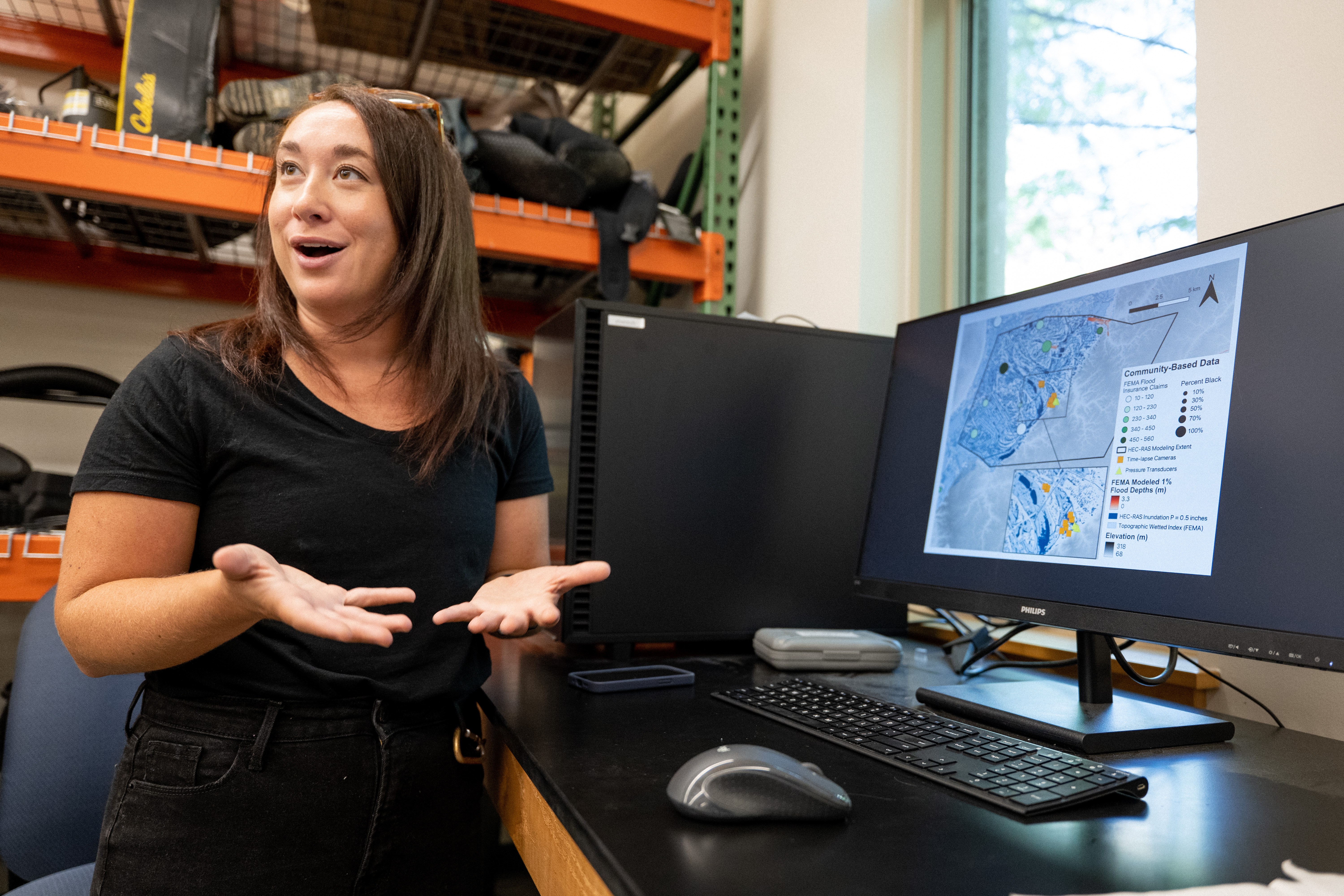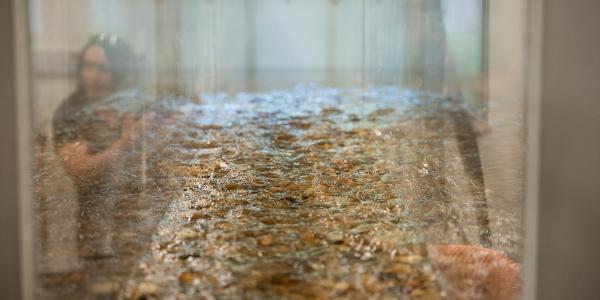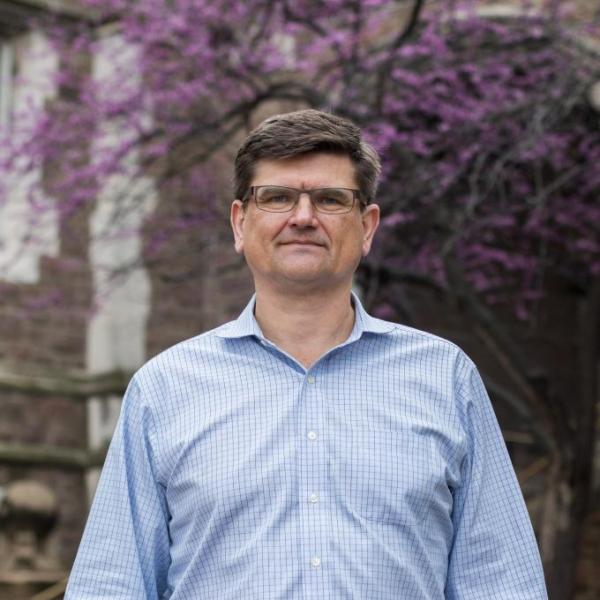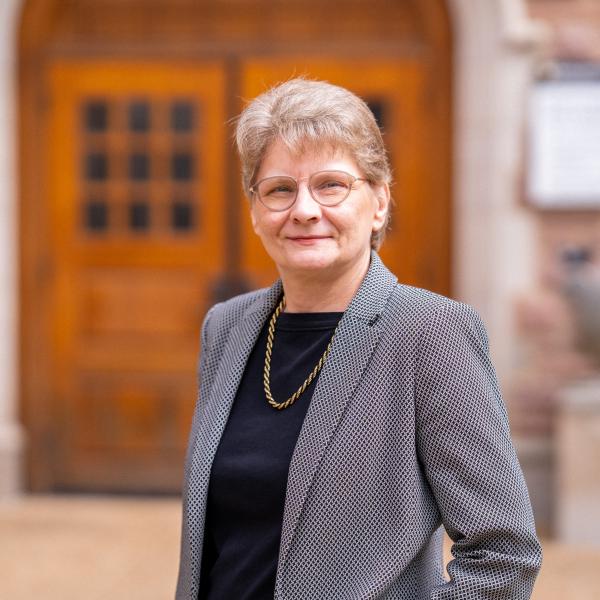Geomorphologist Claire Masteller leverages multiple data sources, geospatial data analysis, and machine learning techniques to paint a holistic picture of Earth’s changing landscapes. By sharing her expertise with local communities, she’s contributing to environmental justice efforts in the St. Louis metro area.
“Everyone heard about the big flood that happened in University City, but nobody knows about the constant flooding happening in Centreville, just 20 minutes away,” said Claire Masteller, assistant professor of Earth and planetary sciences. “That disparity is environmental injustice.”
As a geomorphologist, Masteller is an expert on landscapes. Her research focuses on how landscapes form and change. She aims to better understand why Earth’s surface looks the way it does, how it might respond to future changes in weather and climate, and, critically, how these landscape dynamics impact communities living in those changing spaces.
“Once we understand the underlying physics of landscapes, then we can start asking questions about how a landscape may change — how does the landscape respond to disturbances or shifts in environment? How do those changes affect us?” Masteller said.
According to Masteller, these climate-driven changes have clear implications for environmental justice — as not all communities will be impacted by the consequences of climate change and the associated shifts in landscape dynamics equally, nor will affected communities receive equal support from governments — and her work approaches these entangled issues with both basic and applied science.
“Our landscapes are the place where climate change is ultimately going to be brought to bear, and where it’s going to affect human lives,” Masteller said. “We’ve already seen that play out in a number of different ways, from the historic rainfall event we just had in St. Louis that caused incredible widespread flooding and still has people displaced, to the major fires that are happening out West, to the droughts that are leaving rivers in Europe almost completely dry. The people that live on those landscapes will have to endure the consequences that play out in response to those changes.”
In collaborative research funded by the National Science Foundation, Masteller combines experimental studies of river erosion in her lab with historical flood data and geospatial data from real river channels to quantify how sensitive rivers are to future changes in climate. The work will aid researchers in determining which river systems are vulnerable to erosion and landscape disturbances and provide a foundation for treating rivers dynamically in the next generation of river flood hazard forecasting models.

Masteller is also working with local communities in the St. Louis metro area to ascertain what risks they face as landscapes evolve, particularly when it comes to moving water. In a NASA-funded community study, Masteller will use geospatial data analysis and machine learning to model urban flooding in Centreville, Illinois, integrating NASA’s satellite data with observations gathered by community partners to characterize flood risk more holistically.
“We can provide the scientific underpinning to understand what environmental changes or weather events might result in increasing flood frequency and severity, then identify regions where those risks are elevated and combine that with social and demographic data to begin to address questions related to environmental justice,” Masteller explained.
“Centreville isn’t unique in the sense that it experiences flooding, but it has a confluence of issues that have amplified this issue and led to environmental injustice,” Masteller said. “The community is predominantly Black, it’s one of the lowest income communities in the state of Illinois, and residents often experience severe flooding after only 30 minutes of rain. Even when you account for the natural risks that come from living in a floodplain, it’s clear that the management and engineering decisions have not been sufficient to handle the staggering amount of water piling up on this landscape.”

The consequences of ongoing flooding spill over into social, economic, and health issues. Floodwaters back up sewer systems, limiting access to clean drinking water; repeated water damage to homes can also reduce property valuations, making it nearly impossible for residents to sell their homes and relocate.
Working with the citizens of Centreville, Masteller will deliver her findings to local project partners with the aim of defining flood risk more accurately for the community, providing evidence for infrastructure improvements needed to reduce flooding, and ultimately helping the community achieve their goals for environmental justice.
At the intersection of basic and applied science, Masteller seeks to answer open questions in geomorphology — filling in critical knowledge gaps for judging risk, making predictions, and mitigating hazards — which can make a difference in real people’s lived experience.
“The natural world is complicated, even before human intervention! Trying to unpack and separate all those factors is a really rich problem that we’re able to work on with so many different approaches, especially on Earth, because we have a lot of great data,” Masteller said.
“Even though we’re doing basic research, there’s a clear application to the community and to people’s lives, which I find incredibly motivating.”




